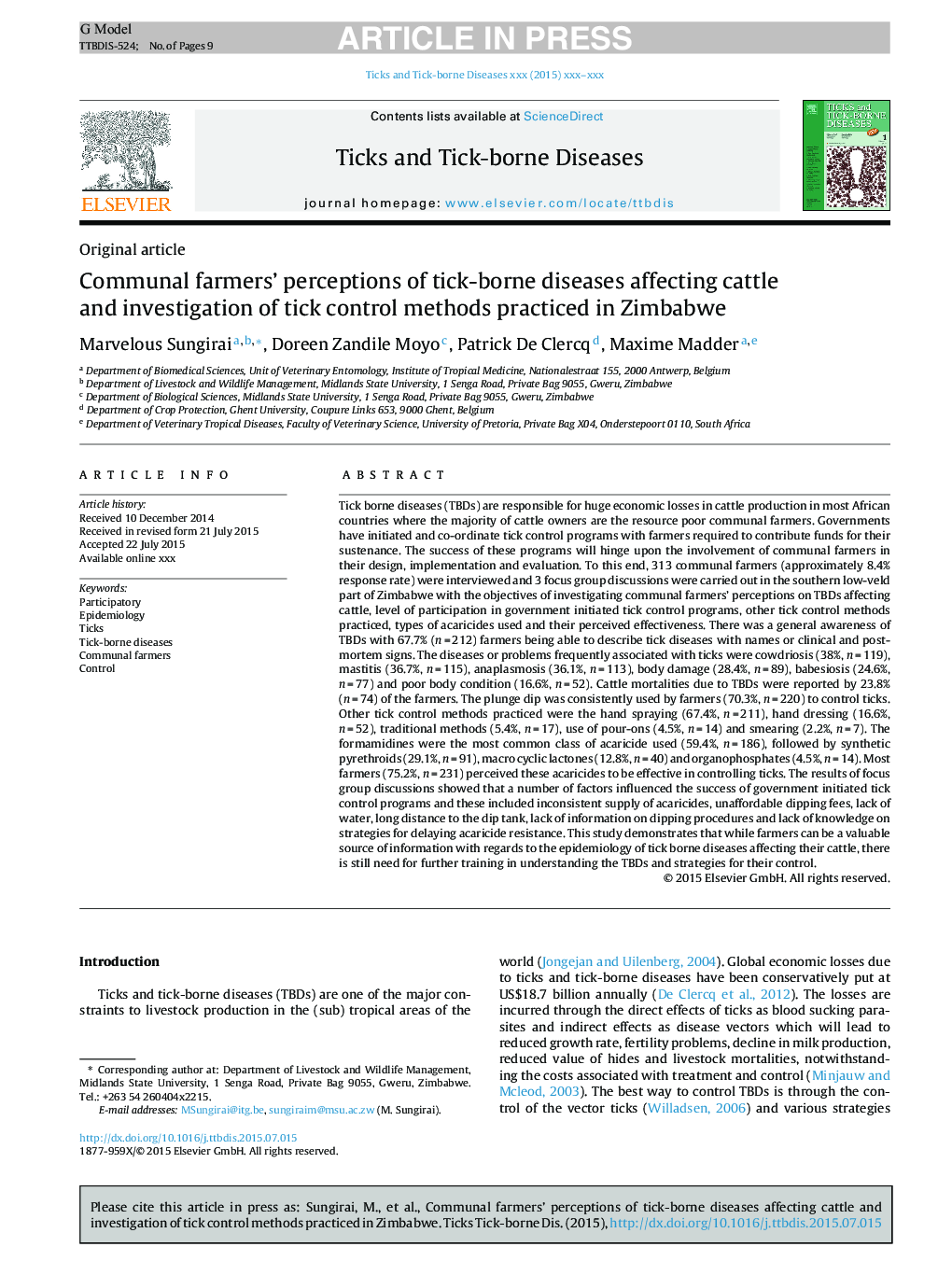| کد مقاله | کد نشریه | سال انتشار | مقاله انگلیسی | نسخه تمام متن |
|---|---|---|---|---|
| 5807001 | 1113102 | 2016 | 9 صفحه PDF | دانلود رایگان |
عنوان انگلیسی مقاله ISI
Communal farmers' perceptions of tick-borne diseases affecting cattle and investigation of tick control methods practiced in Zimbabwe
ترجمه فارسی عنوان
ادراک کشاورزان جمعی در مورد بیماری های تهاجمی که بر گاوها اثر می گذارد و بررسی روش های کنترل تیک در زیمبابوه انجام می شود
دانلود مقاله + سفارش ترجمه
دانلود مقاله ISI انگلیسی
رایگان برای ایرانیان
کلمات کلیدی
مشارکتی همهگیرشناسی، کیک، بیماری های منتقله از راه خون، کشاورزان اجتماعی، کنترل،
موضوعات مرتبط
علوم زیستی و بیوفناوری
علوم کشاورزی و بیولوژیک
علوم دامی و جانورشناسی
چکیده انگلیسی
Tick borne diseases (TBDs) are responsible for huge economic losses in cattle production in most African countries where the majority of cattle owners are the resource poor communal farmers. Governments have initiated and co-ordinate tick control programs with farmers required to contribute funds for their sustenance. The success of these programs will hinge upon the involvement of communal farmers in their design, implementation and evaluation. To this end, 313 communal farmers (approximately 8.4% response rate) were interviewed and 3 focus group discussions were carried out in the southern low-veld part of Zimbabwe with the objectives of investigating communal farmers' perceptions on TBDs affecting cattle, level of participation in government initiated tick control programs, other tick control methods practiced, types of acaricides used and their perceived effectiveness. There was a general awareness of TBDs with 67.7% (n = 212) farmers being able to describe tick diseases with names or clinical and post-mortem signs. The diseases or problems frequently associated with ticks were cowdriosis (38%, n = 119), mastitis (36.7%, n = 115), anaplasmosis (36.1%, n = 113), body damage (28.4%, n = 89), babesiosis (24.6%, n = 77) and poor body condition (16.6%, n = 52). Cattle mortalities due to TBDs were reported by 23.8% (n = 74) of the farmers. The plunge dip was consistently used by farmers (70.3%, n = 220) to control ticks. Other tick control methods practiced were the hand spraying (67.4%, n = 211), hand dressing (16.6%, n = 52), traditional methods (5.4%, n = 17), use of pour-ons (4.5%, n = 14) and smearing (2.2%, n = 7). The formamidines were the most common class of acaricide used (59.4%, n = 186), followed by synthetic pyrethroids (29.1%, n = 91), macro cyclic lactones (12.8%, n = 40) and organophosphates (4.5%, n = 14). Most farmers (75.2%, n = 231) perceived these acaricides to be effective in controlling ticks. The results of focus group discussions showed that a number of factors influenced the success of government initiated tick control programs and these included inconsistent supply of acaricides, unaffordable dipping fees, lack of water, long distance to the dip tank, lack of information on dipping procedures and lack of knowledge on strategies for delaying acaricide resistance. This study demonstrates that while farmers can be a valuable source of information with regards to the epidemiology of tick borne diseases affecting their cattle, there is still need for further training in understanding the TBDs and strategies for their control.
ناشر
Database: Elsevier - ScienceDirect (ساینس دایرکت)
Journal: Ticks and Tick-borne Diseases - Volume 7, Issue 1, February 2016, Pages 1-9
Journal: Ticks and Tick-borne Diseases - Volume 7, Issue 1, February 2016, Pages 1-9
نویسندگان
Marvelous Sungirai, Doreen Zandile Moyo, Patrick De Clercq, Maxime Madder,
